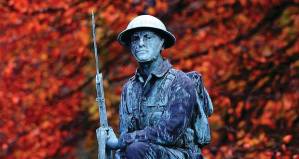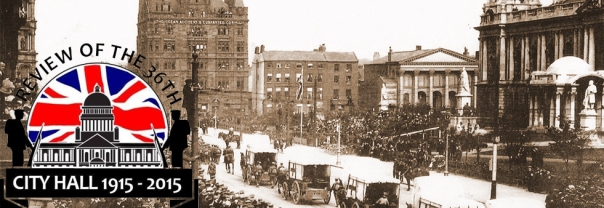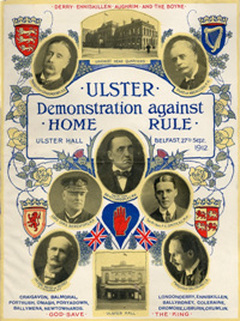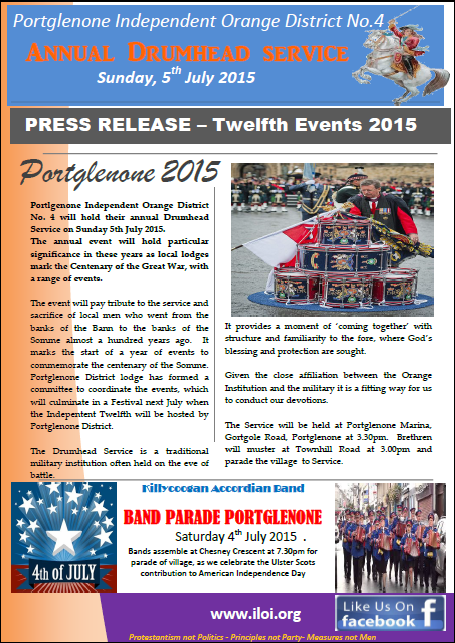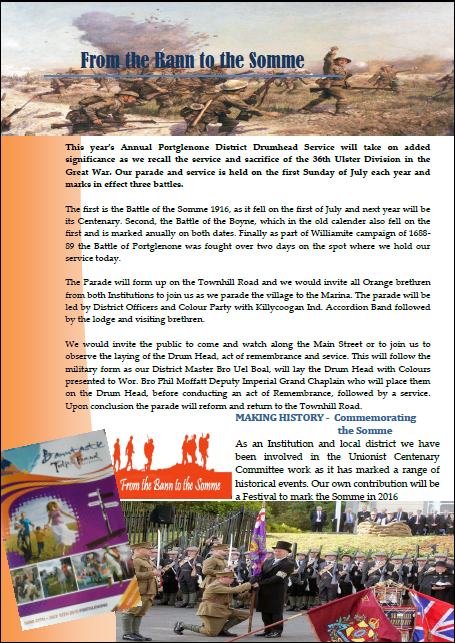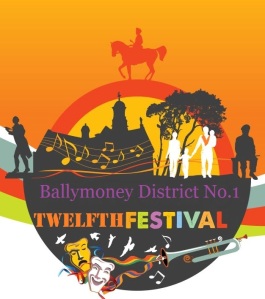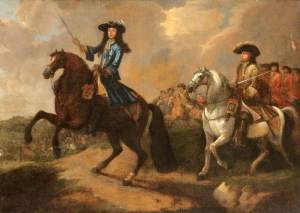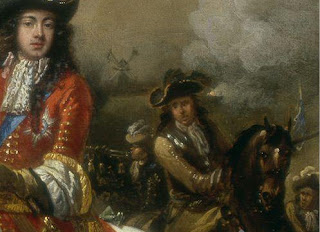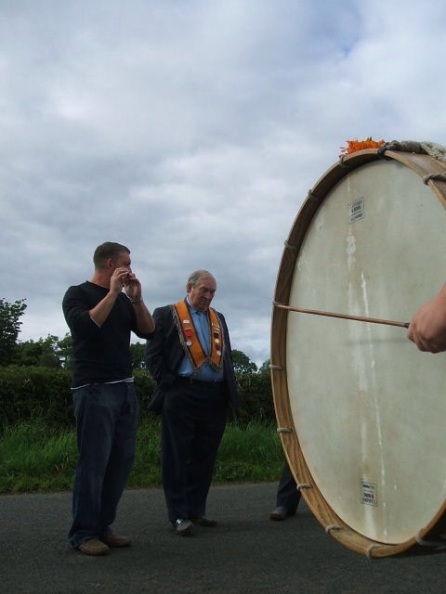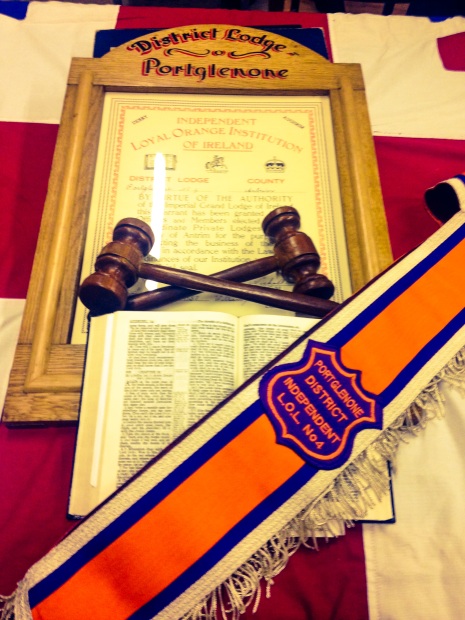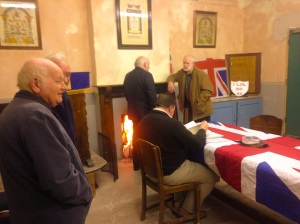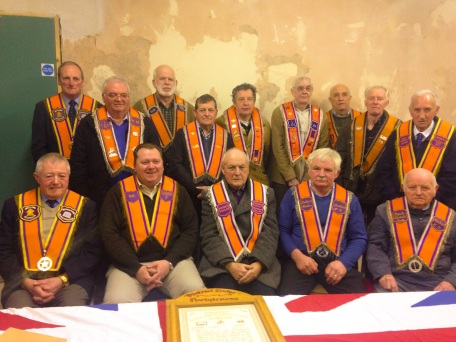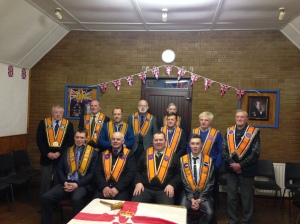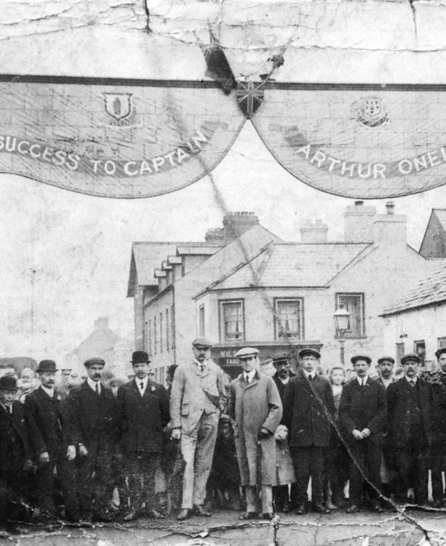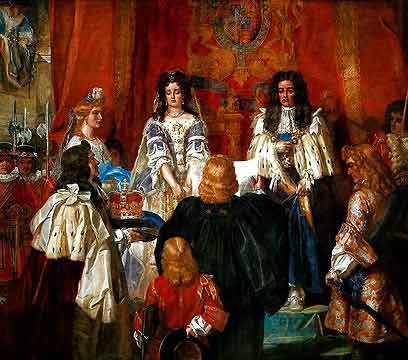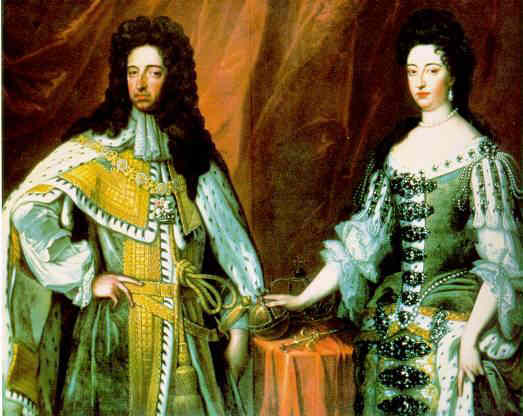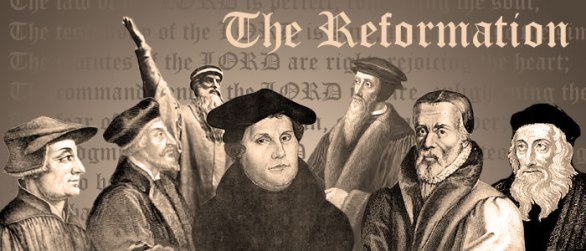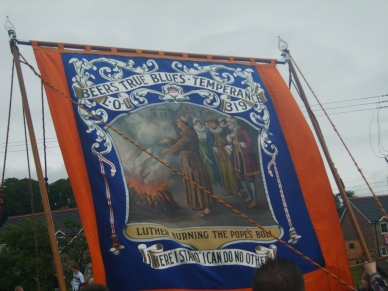Blog Archives
Portglenone Drumhead Service
Portlgenone Independent Orange District No. 4 will hold their annual Drumhead Service on Sunday 5th July 2015. The annual event will hold particular significance in these years as local lodges mark the Centenary of the Great War, with a range of events.
The event will pay tribute to the service and sacrifice of local men who went from the banks of the Bann to the banks of the Somme almost a hundred years ago. It forms the start of a year of events to mark the centenary of the Somme. The local District lodge has formed a committee to coordinate the events, which will culminate in a Festival next July when the Indepentent Twelfth will be hosted by Portglenone District.
The Drumhead Service is a traditional military institution often held on the eve of battle. It provides a moment of ‘coming together’ with structure and familiarity to the fore, where God’s blessing and protection are sought. Given the close affiliation between the Orange Institution and the military it is a fitting way for us to conduct our devotions.
The Service will be held at Partglenone Marina, Gortgole Road, Portglenone at 3.30pm. Brethren will muster at Townhill Road at 3.00pm and parade the village to Service.
This year’s Annual Portglenone District Drumhead Service will take on added significance as we recall the service and sacrifice of the 36th Ulster Division in the Great War. Our parade and service is held on the first Sunday of July each year and marks in effect three battles.
The first is the Battle of the Somme 1916, as it fell on the first of July and next year will be the Centenary. Second the Battle of the Boyne, which in the old calender also fell on the first and is marked anually on both dates. Finally as part of Williamite campaign of 1688-89 the Battle of Portglenone was fought over two days on the spot where we hold our service today.
The Parade will form up on the Townhill Road and we would inbite all Orange brethern from both Institutions to join us as we parade the village to the Marina. The parade will be led by District Officers and Colour Party with Killycoogan Ind. Accordian Band followed by the lodge and visiting brethern.
We would invite the public to come and watch along the Main Street or to join us to watch the laying of the Drum Head and our sevice, and act of remembrance. This will follow the military form as our District Master Bro Uel Boal, will lay the Drum Head with Colours presented to Wor. Bro Phil Moffatt Deputy Imperial Grand Chaplain who will place them on the Drum Head, before conducting an act of Remembrance, followed by a service. Upon conclusion the parade will reform and return to the Townhill Road.
Snapshot from History
At this time the men of the 36th Ulster Division moved to Seaford on the Sussex coast of England. Lord Kitchener inspected the Division there on 27 July 1915, and later remarked to Carson “your Division of Ulstermen is the finest I have yet seen”. Another inspection took place, by King George V, on 30 September.
3-6 October: the Division moved to France, although the artillery remained in England until November.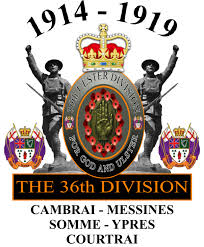
The Ulster Division initially concentrated in the area around Flesselles, some ten miles north of Arras. Gradually, men were sent in groups for familiarisation with trench warfare conditions, and were attached to the regular army 4th Division for the purpose in the (at this time) quiet are north of the River Ancre near Albert.
On 21 October the Division was moved away from the fighting area towards Abbeville, where it spent most of the winter of 1915-16 continuing training. One of the Brigades was attached to 4th Division for several weeks at this time and the artillery finally rejoined.
Come and Join us as we mark this historic event.
Ballymoney Twelfth Festival
We are looking forward to the Twelfth Festival in Ballymoney in the run up to the twelfth of July, so come join us for a range of events. From history to culture, parades to parties the week has it all. beginning on Monday with a historical bus tour and ending with the big day itself!
Faith will be at the heart of all we do and this year to mark the Institutions association with St Jame’s Presbyterian church we will be having a Twelfth morning service there.
We will keep you posted on the events as they happen.
Imperial Grand Lodge Church Service
To mark this connection on Monday 13th July there will be an Imperial Grand Lodge Church Service in Boyle’s old church – St James’s Presbyterian Church at 11.00am followed by annual Demonstration in Megaw Park, parade to leave Park at 1.00pm for parade of Town followed by platform proceedings, Chair to be taken at 2.30pm. Return Parade will leave Park at approximately 4.15pm for parade Coleraine Road, High St and Main St terminating at Seymour Street.
Twelfth 2015
As the Twelfth approaches we are preparing for our Big day, as we mark the annual Boyne celebrations in style.
Like all lodges across the country these weeks are a busy time for us. The Twelfth and all that people see that day does not simply happen, it takes time and money and dedication to bring it all together. As a drumming lodge we have to spend time preparing or ‘pulling’ the drums to ensure there are tight and just right for the big day. Even after weeks of preparation if the rain comes it will all be for nothing, but at least we know they would have sounded well !
The hall itself gets a facelift in time for the big day and the hedges cut and yard tidied, its times like this we envy our brethren in the towns! For smaller lodges the same work has to be done only with less hands and we would appeal for volunteers and helpers to come join us as this is a time for community and cooperation.
This year we will have our Twelfth in Ballymoney and if you would like to join us either visiting brethren from the mainland to walk or families and friends to spectate then drop us a message on here and we will provide details. It promises to be a great day for all and a warm welcome awaits in Ballymoney the home of the Independents.
The week running up to the Twelfth promises to be a fun time for all the family with the Twelfth Festival planned by Ballymoney District. There will be a full programme from historical bus tours to an Ulster Scots Ceidilh featuring local artists, poets and much more, in the ILOL Hall Edward St. Ballymoney.
As a lodge we will be meeting at the Hall then proceeding to Ballymoney for a church service before the main Twelfth Parade.
The Demonstration and Platform Party will be in Megaw Park followed by a return Parade of the town.
So why not plan to join us bring your family and friends and make this your big day too!
Sectarian attacks continue – Cookstown: Orange Order hall attacked in ‘hate crime’
16 November 2014
Cookstown: Orange Order hall attacked in ‘hate crime’
An Orange hall in County Tyrone has been damaged in an attack that police are treating as a hate crime.
Two windows of the building on Fairhill Road, Cookstown, were smashed overnight.
A year ago, the Orange Order said a boulder was thrown through a window of the hall.
Ulster Unionist Party councillor Trevor Wilson said the latest attack was “an act of wanton vandalism”.
“It’s a shame that a hall could elicit such hatred in the minds of people who have nothing positive to offer the community,” he said.
via BBC News – Cookstown: Orange Order hall attacked in ‘hate crime’.
Portglenone District Meeting – December 2014
The Portglenone District Lodge No 4 end of year meeting was hosted by our lodge, and was a well attended popular event. it is always a great privilege for a private lodge to host the District and special efforts are made to ensure its a success.
Members travelled from as far away as Larne to represent a number of private lodges. They were greeted and a warm welcome awaited them around the big open fire which was once a feature of many lodges but has become a rare thing now. However the McNeillstown men keep the tradition of a literal warm welcome alive.
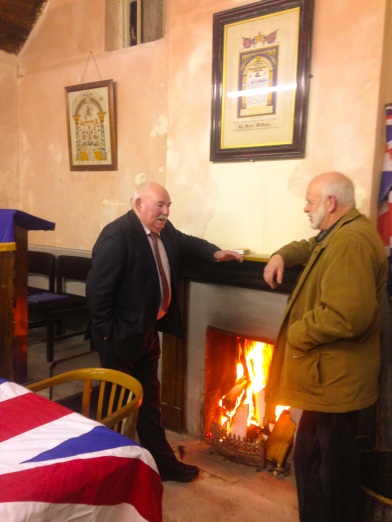 Like many rural lodges it is an informal friendly occasion when old friends meet once more and the talk is as much of families and farming as it is of the business that lies ahead. The evening is as much as social occasion as it is a business meeting with the craic and chat starting long before the meeting and carrying long after it is over. As long as there are peats for the big open fire and enough stories to share men have been know to sit into the wee hours of the morning.
Like many rural lodges it is an informal friendly occasion when old friends meet once more and the talk is as much of families and farming as it is of the business that lies ahead. The evening is as much as social occasion as it is a business meeting with the craic and chat starting long before the meeting and carrying long after it is over. As long as there are peats for the big open fire and enough stories to share men have been know to sit into the wee hours of the morning.
Visiting brethren have a chance to survey the ongoing building work at McNeillstown and offer advice and help on how to take the work forward. Then when the members and all assembled, the meeting was called to order around the big oak and leather board room table which was donated by the late Worshipable Master of McNeillstown Bro Jim Wilkinson. Having been the board room table of one of the oldest banking institutions in Belfast where it survived a PIRA terrorist bomb it was saved and given a new lease of life in the hall. While the business conducted around it now many not be concerned with multi-million pound deals it is every bit as important to the men around it. If table could talk the old bank table would have a few tales to tell.
Remembering the Past – Looking to the Future
The District decided that it would be fitting to mark the centenary of the Battle of the Somme in 2016 in a special way especially as the village hopes to host the Twelfth that year. Members expressed great enthusiasm in organising a range of special events with a range of expertise from local historians and ex servicemen being used to plan our response. The events ranging from parades and exhibitions to school presentations with local men as well as those from north and south who fought and died commemorated.
Brethren who had served with the Irish Guards gave a report on what plans are in place for the official British Army commemoration of the battle, and it is hoped that we can work with them and other organisation committees members are part of to ensure we have the best event possible. Members also spoke of their participation in a range of community based activities to promote our history and culture.
The meeting was closed in due and ancient form with prayer and scripture reading. Afterwards a supper was laid on for the members and visitors with the women of McNeillstown once more outdoing themselves with a range of tasty treats.
Following Family Footsteps at Killycoogan
It was a proud and unique night in the history of Killycoogan as two brothers joined meaning that litersally three generations had followed in the footsteps of others in the lodge. Members of our lodge attended and assisted in the initiation of two new members at Killycoogan ILOL No 48 our neighbouring lodge tonight Tuesday 2 December 2014.
Two Gordon brothers received their degrees tonight making it three generations in the same lodge. It was a proud day for William Gordon Snr and their father William Gordon Jnr. These two new members were Thomas and Ben Gordon sons of WM Bro William Gordon and Grandsons of Bro William Gordon both lifelong members of the Lodge.
Following the initiation normal business was conducted and all present enjoyed an excellent supper provided by the ladies who were suitably thanked for this gesture.
Local MP Commemorated
Commemoration service for first British MP to die in WW1

A local Ulster MP Cpt Arthur O’Neill was the first British MP to die in World War One. His life has been commemorated at Westminster on the 100th anniversary of his death.
The service for Capt Arthur O’Neill, who was elected as the Ulster Unionist Party MP for Mid-Antrim in 1910, was conducted by former Church of Ireland primate of All Ireland, Archbishop Robin Eames.
Capt O’Neill, father of former Northern Ireland Prime Minister Terence O’Neill, and the lodges local MP died while fighting with the 2nd Life Guards regiment at Zillebeke Ridge in Flanders on 6 November 1914, aged 38.
Arthur O’Neill, the elder son and heir of the second Baron O’Neill and Lady O’Neill of Shanes Castle, County Antrim, was educated at Eton. He was gazetted to the 2nd Life Guards from the Militia in 1897 and served in the earlier part of the South African War, taking part in the relief of Kimberley and operations in the Orange Free State at Paardeberg, the action at Dreifontein, and the action at Colesberg.


Afterwards, he served in Cape Colony, south of the Orange River, and took part in several actions, for which he was awarded the Queen’s Medal with three clasps. He was promoted to captain in 1902.
In 1902, he married Lady Annabel Hungerford Crewe-Milnes. Two of their sons were to die in action in World War Two.
Capt O’Neill represented Mid-Antrim from the general election of January, 1910 and took an active part in the formation of the Ulster Volunteer Force. Like many of the great unionist families he was anti-Home Rule and, along with Sir William Adair and the Youngs of Galgorm Castle, played a key role in the establishment of the local Ulster Volunteer Force. His military background was invaluable in establishing drilling and training regimes for recruits.
Arch in Henry Street, Harryville, erected to support Captain Arthur O’Neill in his campaign for election to Westminster in 1910. Capt O’Neill can be seen in the centre and George Young is the tall man beside him.
He rejoined his regiment only three weeks before his death. He was killed in action at Klein Zillebeke ridge in Belgium during a bayonet charge while serving with A Squadron, 2nd Life Guards and was the first sitting member of the British Houses of Parliament to be killed during the Great War.
The following is an extract from the Regimental War diary of the events of that time
” The Regt was placed in Reserve in the woods near the 4th Guards Bde H Q. At about 3.30 pm the Bde was urgently sent for and hurried towards ZILLEBEKE to support the French on the right of the Guards Bde who had been driven out of their trenches by a most determined attack.
The Regiment was dismounted under fire close to the above mentioned village and was ordered to establish iteself on the KLEIN ZILLEBEKE ridge keeping touch with the 1st Life Guards on the right who were to ? the line on the right of the Guards Brigade. Maj. the Hon. H. DAWNAY ordered the ‘B’ squadron to advance ? across the open and ? the high ground in front. ? the ‘D’ squadron was send across the ZILLEBEKE – ZWARTETEN road to ? the right flank by moving parallel to the railway. The ‘C’ troop and machine guns were kept in reserve ready to support the ‘B’ squadron. This latter squadron succeeded in reaching the edge of the wood on the ridge after ? fighting owing to the ? bring in ? of ? in?ted horses. Almost at? once the right flank of the ‘B’ became exposed to an enfilade? fire which caused Maj. DAWNAY to order the squadron to fall back slowly by troops. This order was shortly afterwards countermanded owing to French reinforcements appearing. The squadron was then ordered to fix bayonets and charge the wood which the C troop was taken by the C O to fill the gap which had occurred in between the two squadrons. This troop ? attacked the village of ZWARTETEN using the bayonet with great effect and taking a certain number of prisoners. The ‘B’ sqdn meanwhile drove back the enemy several? hundred yards and occupied a ditch 200* from their position. Owing to the trench infantry again falling back the ‘B’ sqdn and the Blues were ordered by the Brigadier to move across the ZWARTETEN – VERBRANDEN-MOLEN road and support the ‘C’ troop which was occuping a single ridge S E of the hamlet. The fighting in this vicinity became very involved owing to the somewhat precipitate retreat of the French and in consequence severe casualties were incurred. Part of the ground gained including a portion of ZWARTETEN was lost?. The situation which was becoming somewhat critical was restored by the ? of the 22nd Infantry Bde which took over the trenches held by the Bde. During these operations the ‘D’ sqdn did not fall back but retained their ground till relieved by the 60th Rifles. The confusion that occurred at one period apart from the aforementioned reason may be attributed to the very severe casualties amongst the officers / 17 in the Bde, Lord Cavan [Brigadier-General the Earl of Cavan] commanding 4th Guards Bde reported that the Bde had behaved in a most gallant manner, and that its prompt and vigorous action had saved what threatened to be a most critical situation.
MARGIN NOTES
Ref. Sheet 28
BELGIUM
*The other 3 troops of ‘C’ squadron were posted on 30th Oct at ZANBE?
Casualties
Killed
Maj. The Hon. H. DAWNAY
Maj. The Hon. A. O’NEIL[L]
2 Lieut. W. PETERSEN
Wounded
2 Lieut. T. JOBSON
Lieut. Q. SANDYS
2 Lieut. A. HOBSON
38 rank and file killed, wounded and missing
3 horses killed
The entry for this eventful day looks to have been hastily written, and is therefore difficult to read in places.

“O’NEILL, Arthur E. B., Captain, 2nd Life Guards, was KIA on the 4th [sic] November 1914. He was aged 38 and was the 2nd son of Baron O’Neill of Shane’s Castle, Randalstown.. He was the MP for Mid-Antrim and was the first MP to die in the war. He is commemorated on the Ypres Memorial (Menin Gate), Belgium.” (from Ballymena 1914-1918)
More on the officers killed on this day from Ballymena 1914-1918
His younger brother Hugh, later Baron Rathcavan, succeeded him as MP for Mid-Antrim.
 Capt O’Neill was killed three weeks after rejoining his regiment
Capt O’Neill was killed three weeks after rejoining his regimentLocal Heroes
We have already received responses from our appeal for the names and faces and stories of local heroes who both served and paid the ultimate sacrifice in both World Wars. We intend to post the information as and when it comes in then take some time to research and draw it up.
Rifleman Robert Connaughty

Rifleman Robert Connaughty from Garvaghy, Portglenone. He joined the army as a volunteer in November 1915, being posted to the 18th Btn. Royal Irish Rifles for training before being assigned to the 11th Royal Irish Rifles (South Antrims). He served with ‘A’ coy. of that battalion on the first day of the Somme when he was almost buried alive by an exploding shell which killed several of his comrades. His army service records confirm he was amongst the wounded of 1st July and was diagnosed with ‘shell shock’ on 5th July 1916. He was again wounded in 1918.
We are aware of Bro Tommy Connaghty from Drumraw and wonder if this is the family connection?
Thanks to the research conducted by the team at
The Significance of the Williamite Revolution Settlement
Lecture at the Opening Seminar of the European Institute of Protestant Studies
Professor Arthur Noble
In the short time allocated to me I am going to attempt a simplified analysis of the significance the Williamite Revolution Settlement in its broader context, both historically and constitutionally.
The term ‘Revolution Settlement’ refers collectively to the provisions stretching from the Bill of Rights of 1689 to the Act of Settlement of 1701, both inclusive. These and the intervening pieces of legislation were the culmination of the great historical struggle of this country against the Papacy, and together they secured our Protestant Throne and Constitution and all the rights and liberties which are guaranteed thereby. Doctrinally speaking, these were the fruit of the Reformation, but their enactment was not secured until after the Siege of Londonderry and the Battle of the Boyne.
The Monarchy versus the Papacy in British History
The significance of the Revolution Settlement is inextricably linked to the principle of the Monarch as Defender of the Protestant Faith. The uniqueness of our Monarchy is a result of the history of our nation. In the centuries before the Reformation that history was dominated by a long struggle for the freedom of our Kings and Queens from the domination of the Papacy, but even after the victory of the Reformation and following the Williamite Settlement the attacks by the Vatican on our independence from its control have continued in ever more subtle ways.
In mediaeval times the historical claims by the Vatican to be above civil governments were staunchly and openly maintained against Britain. Papal aggression led to the signing of the Magna Carta, granted by King John at Runnymede in 1215, which was the very foundation of British liberty and provided for the trial of freemen by the civil law. This great document was, in a sense, the mediaeval forerunner of the Revolution Settlement.
In 1392 Richard II also anticipated the Revolution Settlement by declaring:
[…] the Crown of England hath been so free at all times, that it hath been in no earthly subjection, but immediately subject to God touching the regality of the said Crown, and no other.
Again, in 1534, Henry VIII acted on the same principle with a Parliamentary Act abolishing the Papal supremacy in England and proclaiming the independence of his Crown. He was only partially successful, though in 1537 the Parliament at Westminster did decree “the utter abolition of the jurisdiction of the Pope of Rome”.
From then onwards, however, throughout the period leading up to the Reformation, the claims of the Papacy were steadily built up and enforced with varying success, and although the Reformation dealt them a major blow, a struggle of another century and a half had yet to take place before Britons became convinced that the independence of their Throne was unattainable while a Papist sat on it, because their liberties and those of their children would be strangled or bartered away.
The Significance of the Reformation in shaping the Revolution Settlement
The Revolution Settlement was made possible by – and was the culmination and crowning glory of – the great doctrinal Reformation which had taken place a century and a half beforehand, in the sixteenth century. We must therefore appreciate what we owe to the Reformation before we can understand its part in shaping the Revolution Settlement.
The Reformation gave us all that was worth having: liberty of conscience, liberty of faith, freedom of discussion and freedom of the press. Doctrinally speaking, no monopolising priest could now come and stand as a barrier between the sinner and the Lord Jesus Christ; but the Reformation also brought us social blessings and political greatness. In his book Popery its Social Aspect, R.P. Blakeney writes:
The Reformation has been the stay, and bulwark, and glory of England. […] When Britain became Protestant, taking the Word of God for her guide, – when the principles of the Bible regulated all her actions and legislation, – when she acknowledged it as her first duty and highest privilege, as a nation, to advance the cause of Christ, and framed her laws and institutions to that end only, – when she had cast off all connexion with Popery, declaring it illegal even to enter into diplomatic relations with Rome, […] she enjoyed the favour of Heaven, and became great; her people rose in character and intelligence, and manliness and honesty distinguished their conduct. Her arms prevailed; and the British constitution and British laws – the best that ever existed – were the admiration and praise of all the earth.
Rome’s Attempts to undo the Reformation
Rome, nevertheless, continued her assaults. We might mention the attempt by Pope Pius V to subvert the Protestant Queen Elizabeth I. In 1569 he issued a bull which declared her “an heretic, and a favourer of heretics”, and throughout her reign at least 21 assassination attempts in 25 years were made on her by the Vatican. Again, in 1588, the Pope urged Philip of Spain to attempt to destroy British liberty and Protestantism by means of the Spanish Armada. Another Romanist attack was the failed Gunpowder Plot of 1605 in the reign of King James I, who gave us the Authorised Version of the Bible.
Before the 17th century ended, our Monarchs themselves were to be used subversively by the Papacy to endeavour to destroy the Reformation and the Protestant Throne. Charles II and James II were both Roman Catholics.
Charles II (1660-1685) was a secret Papist, but James II (1685-1688) was publicly converted to Romanism and tried to re-impose Popery on England by passing an Act of Toleration. He violated the principles of Constitutional government and of the Reformation, and for this treacherous dealing he justly forfeited his Crown. Having succeeded in papalising the army in Ireland, he met his doom, as all Ulster people know, on the banks of the Boyne.
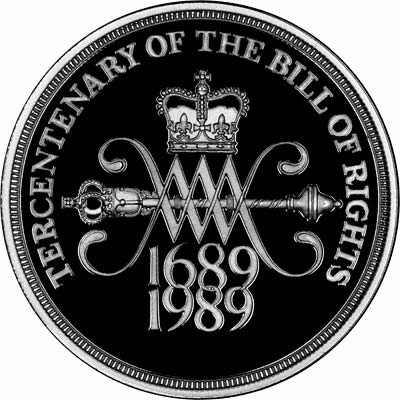 The Course and Provisions of the Revolution Settlement
The Course and Provisions of the Revolution Settlement
Let us now examine specifically the course and provisions of the Revolution Settlement and its contribution to the Constitutional freedoms which we have enjoyed for the past 300 years.
When William, Prince of Orange, landed on our shores in 1688, he pledged himself to maintain our Protestant liberties, and ascended the English Throne as William III (1689-1702). The Convention Parliament declared on 28th January, 1689, that King James II had “endeavoured to subvert the constitution of this kingdom, by breaking the original contract between King and people” and had “by the advice of Jesuits […] violated the fundamental law”. He had therefore “abdicated the Government” and the Throne was “thereby vacant”. On 13th February this resolution was extended to include the following words: “That William and Mary, Prince and Princess of Orange, be and be declared, King and Queen of England, France and Ireland, and the dominions thereunto belonging.”
At the Siege of Londonderry and the Battle of the Boyne which was to follow soon afterwards, Ulster became Britain’s Protestant bastion, and the forefathers of this great Nation – unlike the myopic weaklings who lead it today – had the wisdom to do what patriotic warriors do on the termination of a hard-fought and successful campaign: they built ramparts around their rights and liberties.
The most important of these ramparts was the Revolution Settlement itself. It established a Protestant Throne, a Protestant Legislature and a Protestant Electorate. The 1689 Act declared the rights and liberties of the subject and set the Succession of the Crown. Today Queen Elizabeth II remains the “Defender of the [Protestant] Faith”. The ‘ramparts’ were put in place through the Bill of Rights (1689) and the Act of Settlement (1701).
The Bill of Rights (1689)
From the time of William III till the present an Act has been in force which is known as the Bill of Rights. It is described as “an Act declaring the rights and liberties of the subjects, and settling the succession of the Crown”. This Act pronounced it “inconsistent with the safety and welfare of this Protestant Kingdom to be governed by a Popish Prince, or any King or Queen marrying a Papist”; and enacted “that all and every Person or Persons that is, are, or shall be, reconciled to, or shall hold communion with, the See or Church of Rome, or shall profess the Popish religion, or shall marry a Papist, shall be excluded, and be for ever incapable to inherit, possess or enjoy the Crown and Government of this Realm and Ireland and the dominions thereunto belonging”; and further, that “in all and every such case or cases the people of these realms shall be and are hereby absolved of their allegiance, and the said Crown and Government shall from time to time descend to, and be enjoyed by, such Person or Persons, being Protestants, as should have inherited and enjoyed the same in case the Person or Persons so reconciled, holding Communion, or professing, or marrying as aforesaid, were naturally dead.”
The culmination of the Glorious Revolution came with the Act of Settlement of 1701. Having laid down the succession in the Bill of Rights of 1689, Parliament now went on to clarify it more fully. Eight articles were inserted in the Act of Settlement, the most significant being the first, which declares: “That whosoever shall hereafter come to the possession of this Crown shall join in communion with the Church of England as by law established.”
The Act of Settlement also requires every English Sovereign, on coming to the Throne, to deny on oath that any man can change bread and wine into the body and blood of Christ, and to confess on oath that Mary worship, and the Romish mass, are “superstitious and idolatrous”.
Both the Bill of Rights and the Act of Settlement were the result of determination to prevent the recurrence of such abuses that led to the Siege of Londonderry after the first Irish Parliament had passed a rash of iniquitous and tyrannical laws, including the Act of Attainder, depriving Protestants of all their rights and privileges and confiscating their land and goods.
Three Great Constitutional Principles
These two documents laid down the three great Constitutional principles of the Revolution Settlement. If these three basic principles of the Revolution Settlement should ever be dismantled, the Constitutional implications for Britain would be disastrous. She would undo two thousand years of struggling to be free, and revert to a state of serfdom to the Church of Rome such as pertained in the Middle Ages. The principles were:
- A Protestant Throne
In Act I, chapter 2, section 2 of the Act of Settlement the succession to the Crown was finally settled by the following decree:
Every person who is or shall be reconciled to, or shall hold communion with the See or Church of Rome, shall be for ever incapable to inherit, possess or enjoy the Crown or Government of this Realm and Ireland; and in every such case the people of these Realms shall be and are hereby released from their allegiance.
The principle of the victors was that a Monarch who is to rule over free men must himself be free. A King who is under the control of the Pope is not and cannot be free. He is the servant of a master who claims his whole obedience implicitly. Some may argue that Edward III and other Roman Catholic monarchs were not just such slaves; however, they were good British kings only to the extent that they were bad subjects of the Vatican. The more popish, the more slave. Whatever freedom the Kings and Queens of Britain enjoyed, they owed to their refusal to submit to the fetters in which the Pope attempted to hold them. This fact is seen repeatedly in British history. Our Sovereigns always had to maintain a running battle with the Vatican.
To those who pretend that the safeguarding of a Protestant Throne amounts to religious discrimination against Roman Catholics it must be pointed out that the Sovereign, as a man or woman, has every right to change his or her religion; the Sovereign, as Sovereign, however, has no such privilege.
The Protestant Constitution of this country is also enshrined in the Coronation Oath which the Monarch swears prior to the enthronement in Westminster Abbey. The Archbishop, in administering the Coronation Oath, first asks the Monarch: “Is your Majesty willing to take the Oath?” The Monarch answering: “I am willing”, the Archbishop then asks the King three questions, demanding of him first, if he will solemnly promise and swear to govern his people according to the laws and customs of the Constitution; secondly, if he will do his best to cause law and justice, in mercy, to be executed in all his judgements; thirdly, if he will to the utmost of his power maintain the Laws of God, the true profession of the Gospel and the Protestant Reformed Religion established by law, and also maintain and preserve the Church of England and the rights and privileges of the bishops and clergy and the Churches committed to their charge.
To each of these questions, the Monarch gives his solemn assent, and then rising out of his chair he goes to the Altar, attended by two Bishops and the Lord Great Chamberlain, the Sword of State being carried before him. There he makes his Oath in the sight of all the people, laying his right hand upon the Holy Gospel in the Great Bible and says: “The things which I have here before promised, I will perform, and keep. So help me God.” Then the King kisses the Book and signs the Oath. In this solemn manner the Monarch takes the Coronation Oath to uphold “the Protestant Reformed Religion established by law”.
Also on the accession each Monarch takes the Accession Oath before the Privy Council as follows: “I do solemnly and sincerely in the presence of God, profess, testify, and declare that I am a faithful Protestant, and that I will according to the true intent of the enactments which secure the Protestant succession to the Throne of my Realm, uphold and maintain the said enactments to the best of my powers according to the law.”
Then the Monarch takes the Oath relating to the security of the Church of Scotland.
- A Protestant Legislature
The second part of the Revolution Settlement was the establishment of a Protestant Legislature. The men of the Revolution decreed that the subjects of Great Britain would be governed by British law – law made on the soil of Britain, law inspired by the genius of British liberty, law that would conserve those rights and freedoms which had been won in the struggles of the two previous centuries. The men of the Revolution were determined to avoid a repetition of past experience.
They declared that those of the Romish communion were in no proper sense citizens of this country. Their country, they said, is their Church, their King the Pope. A man cannot be subject to two different kings and be loyal to both. No sovereign state can allow its citizens to be at the beck and call of another that also claims temporal allegiance over him. Roman Catholics are subjects of a foreign prince, to whom, without concealment, their allegiance is given, and by whom their conscience in all matters is absolutely ruled.
Every Roman Catholic bishop, after all, takes a feudal oath to obey the Pope in all things, and to fight against his enemies, and that obligation runs down through the priests to the humblest member of their community. It links them all into a great feudal confederacy whose throne is the Vatican and whose country is their Church.
The principle of a Protestant Legislature was based on the idea that only the loyal citizens of a country are entitled to take part in framing the laws by which it is governed. What could be a more glaring violation of the natural law of self-preservation than to commit the government of a country into the hands of those who are aliens to it, and who, even while professing loyalty, may be its secret and most bitter enemies? Such a decision would be national suicide. Hence the men of the Revolution restricted the task of legislating for the country to the citizens of the country, that is, to Protestants, but they did not, however, discriminate against Roman Catholics as such. They extended the protection of British law to all who lived on British soil. They guarded the persons, the lives and the property of Roman Catholics as sacredly as those of Protestants; but they excluded the former from the making of British laws because this was not one of their natural rights. To have granted them this privilege would have re-introduced tyranny into the State and sown the seeds of its gradual subversion.
It is a measure of Britain’s forgetfulness and folly that she granted Roman Catholics the franchise a century later, in 1793. Predictably, they proceeded to gain access to Parliament and to establish themselves in positions of power, denying their subversive intentions behind a cloak of emancipation or, more recently, one of civil rights. Within the past two hundred years they have succeeded in subverting the main Protestant Churches by means of the great deception of the Ecumenical Movement. Cardinal Heenan’s friendship with the late Princess Diana revealed how Rome had been trying to subvert the Protestant Throne directly in a country where Roman Catholics represent a very small minority of the population.
- A Protestant Electorate
Having provided for allegiance by British citizens to the Throne and established their submission to the Law, the men of the Revolution realised that these two principles were wanting in the case of adherents to the Papacy because Roman Catholics could bear little or no allegiance to a Protestant Throne and could show no respect for Protestant Law beyond what force or appearance might compel. In actual fact, it was argued, Roman Catholics appeal to the authoritative principles of their own creed, to their own published manifestos, and above all to – and I quote from the Act:
their repeated and desperate attempts, with arms in their hands and treason in their hearts, to establish this foreign rule over us, not content to being themselves free to submit to it. […] It matters not where their king lives […] – the fact that concerns us is that it is to him that their allegiance is sworn, and it is his law by which their conscience is ruled; and so long as they cleave to this foreign authority, we judge them outside the limits of the State and refuse them part or portion in the government of a nation to which they do not belong.
Let it be remembered, however, that if Roman Catholics were voted outside the pale of citizenship for electoral purposes, this was done not because their religion was false (which it was), but because theirallegiance was wrong. No judgement was, in fact, being pronounced on their creed. They received equal protection under the law, but were not permitted to have a part in making it.
Our Constitutional Rights
The Revolution Settlement brought with it the establishment of certain well-defined Constitutional rights. By the Bill of Rights, the Act of Settlement, and the Coronation Service, our legal rights as Protestant citizens of this country are at least threefold:
- We have an absolute right of exemption from the rule of any Papist who may claim the Throne, even though he be the heir apparent.
- We have an absolute right of exemption from the rule by any person, whether Papist, Romaniser, or lukewarm Protestant, who refuses to denounce by name, and on his solemn oath, the fundamental heresies of Rome, or who subsequently refuses to swear that he will maintain God’s law, Christ’s Gospel, and the Protestant faith, to the utmost of his power.
- We have an absolute right, if any monarch apostacizes from the Protestantism which he has espoused on oath, and becomes a Papist, or if he even “holds Communion with the See or Church of Rome”, to rise collectively and refuse to own him as our King.
These rights, won at such cost, have also, of course, been incorporated into the judicial and constitutional systems of every country in the British Commonwealth.
Results of the Revolution Settlement
What were the practical results of the Revolution Settlement? Its wisdom is attested by the instant leap upwards taken by our country amongst the nations of the world. In a word, its establishment of Protestant principles made England great. England became Great Britain, and the little British Isles sprang into the mightiest empire that the world had ever seen – not by force of arms, but by moral power. From that time Britain was obeyed to the ends of the earth, not by the force of the sword, but by the mightier force of that good name which equitable laws and free institutions won for her.
The indisputable reason for Britain’s prosperity is found in the Bible, and it is that God still does bless nations who obey Him, as he promised Eli of old in I Samuel 1:30: “Them that honour me I will honour.” God kept His promise.
Hence, interwoven with the history of the past three hundred years is the record of unparalleled political progress and unceasing commercial success. Even the Catholic Times of 10th August, 1900, admitted that all this was achieved “under the rule of Protestant sovereigns, under the guidance of Protestant leaders, under the government of Protestant Parliaments, has so associated the Pro-testant idea with England’s success that in the minds of men one is linked to the other as cause and effect.”
Rome’s Claws are growing again
The Church of Rome has been continuing to assault each and every principle of the Revolution Settlement ever since.
Ironically, Britain’s retreat from the principles of the Revolution Settlement began just over a century after its conclusion; for a great betrayal of Protestantism and the elimination of the Protestant safeguards of the Revolution Settlement commenced in earnest with the so-called Catholic Relief Act in 1829. During the second half of the 19th century Rome shadowed all of Britain’s missionary activity abroad and made a desperate effort at home to secure a renewed ascendancy in Britain and its Empire.
Britain foolishly responded by granting concession after concession, till in 1910 the Constitutional Denunciation of Idolatry and the Denunciation of Priestcraft and Popery had been eliminated from the Royal Declaration. These alterations to the Statutory Declaration were made, moreover, without an appeal to the nation, clearly to placate the Church of Rome.
The Undermining of the Protestant Faith
 It has been said that the three great liberties that were obtained during the reign of King William III were a free Parliament, a free press and a free pulpit. Today the European Union is encroaching increasingly on the law-making process in our Parliament; our press displays a distinct bias against Protestant fundamentalism; and many of the once soundly Protestant pulpits of many of our Churches have become choked with the doctrines of Ecumenism. The EU has been described by the Papal Nuncio in Brussels as “a Roman Catholic Confederation of States”, and it has been hailed in Roman Catholic circles as a resurrection of the Holy Roman Empire.
It has been said that the three great liberties that were obtained during the reign of King William III were a free Parliament, a free press and a free pulpit. Today the European Union is encroaching increasingly on the law-making process in our Parliament; our press displays a distinct bias against Protestant fundamentalism; and many of the once soundly Protestant pulpits of many of our Churches have become choked with the doctrines of Ecumenism. The EU has been described by the Papal Nuncio in Brussels as “a Roman Catholic Confederation of States”, and it has been hailed in Roman Catholic circles as a resurrection of the Holy Roman Empire.
Our successive British Governments have been pandering to it, while the Church of England and the other Ecumenical Churches have been pandering to the Church of Rome, which has already gained a considerable section of the Anglican clergy. The question now arises as to whether Queen Elizabeth will be the last British Monarch to take the Protestant Coronation Oath. May God forbid.
The Protestant faith of Britain has been progressively undermined, and British freedoms assailed, by a disciplined and able confederacy intent on destroying them both. The determination of the Papacy to destroy religious freedom in Britain was expressed in the words of Cardinal Manning in The Tablet of August, 1859:
If ever there was a land in which work is to be done, and perhaps much to suffer, it is here. I shall not say too much if I say that we have to subjugate and subdue, to conquer and rule, an Imperial race; we have to do with a will which reigns throughout the world, as the will of old Rome reigned once; we have to bend or break that will which nations and kingdoms have found invincible and inflexible . […] Were heresy [i.e., Protestantism!] conquered in England, it would be conquered throughout the world. All its lines meet here, and therefore in England the Church of God [!] must be gathered in its strength.
We are told that our controversy with Rome is out of date, that the enlightenment of the 20th century has finally defeated any attempt to subjugate the intellect of present or future generations to a false creed, un-Christ-like in its doctrine and cruel in its practice – in other words that the Papacy of 400 years ago, having caught the spirit of the modern age, is no longer the tyrant and dictator of the past – that the pages of history relating to the reign of terror in the days of Queen Mary or the Spanish Armada or the Gunpowder Plot are facts to be eliminated from memory or the teaching of history – horrific extravagances of some remote age incapable of repetition today.
How far these spurious and untruthful arguments are the result of Jesuit cunning is not immediately evident until one considers such events as the Vatican’s massacre of 250,000 Orthodox Serbs in Croatia during World War II, the cruel treatment of many Protestant families in France or the vicious campaign of ethnic cleansing conducted against the Protestants of Northern Ireland. The bloody and brutal Inquisition is an institution which we will forget at our peril, for the Church of Rome still maintains and justifies today her ancient motto:Semper Eadem (Always the Same). Rome will never tolerate her opponents, as one of her early 20th-century Irish Bishops, Dr. Clancy, reaffirmed regarding the Inquisition:
It may be said that those laws were cruel and tyrannical. Granted; yet, surely, we are not to measure the punishments inflicted in the 16th century by the refined standards of our more educated and civilised age. […] The question whether punishment was excessive, however, does not touch the principle, that heresy may become dangerous to the public weal, and as such may be punished by the State. Indeed, the proposition is indefensible – that toleration, where error can be prevented, is intrinsically wrong.
There are churchmen in Ulster today who are arguing passionately and fervently for compromise with Rome. They have ditched the principles of the Reformation so providentially secured for us through the Revolution Settlement. The only difference is that they do not think they would suffer death and torture for opposing the tyrant, for the tyrant is masquerading as a peacemaker; he has been elevated by the Clintons and Blairs of this world to look respectable; he may be dressed in a suit, but he is a gunman; he may be posing as a politician, but he is a terrorist. There is no degree of murder or destruction, no campaign of ethnic cleansing or harassment of Protestants and Unionists strong enough to convince these churchmen of the error of their ways, simply because they are traitors, fraternisers and collaborators who are consciously and deliberately selling out their people to the enemy. They must not be allowed to succeed.
May God awaken our Nation to the urgent and vital need to turn again to His ways, to stop appeasing Romanism and its apologists, and to defend without fear or excuses the Protestant principles which made our country great.
The Protestant Reformation
On October 31, 1517 Martin Luther nailed his 95 Theses on to the door of the Castle Church in Wittenberg, Germany. His actions sparked the Protestant Reformation and his teachings emphasized mans sinfulness, God’s grace and salvation through faith alone. Martin Luther wasn’t the only man to protest what was going on in the Catholic churches though. Men like Huldreich Zwingli (Switzerland), John Calvin (a French theologian), and John Knox (Scotland) were also influential in the Reformation.
From these reformers comes the Five Solas:
- Sola Scriptura: Scripture alone
- Sola Fide: faith alone
- Sola Gratia: grace alone
- Solus Christus: Christ alone
- Soli Deo Gloria: to the glory of God alone
Luther’s Stand Against Rome
It was Luther’s defiance of Papal Authority which challenged the largest and richest organisation in the world at that time. He denounced its errors and ignored the orders of the Pope known as ‘Papal Bulls’, burning them publicly.
He famously nailed his 95 Theses or Points exposing the error of Rome to a church door. This sparked the debate and action which led to the Protestant Reformation. As a Lodge we feel that this great event has been erased from our history, it is neither taught in school or sadly in church, and we trust through our work that it may once more inform and inspire Protestant action in successive generations.

